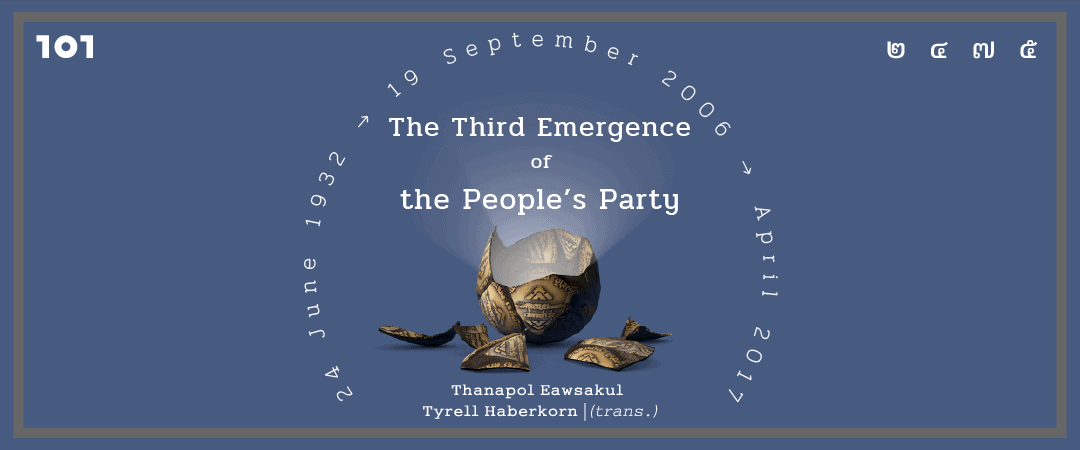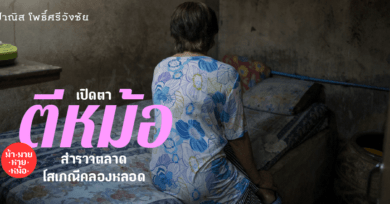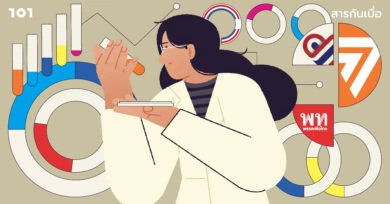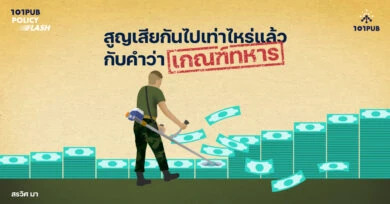written (in Thai) by Thanapol Eawsakul (July 2017)
translated by Tyrell Haberkorn (June 2018)
[box]
On 24 June 1932, the People’s Party, a coalition of civilians and military officers, fomented a transformation from absolute to constitutional monarchy in Siam. Four years later, on 10 December 1936, a brass plaque to commemorate the transformation was embedded in the road at the location near Dusit palace where they had gathered at dawn on that momentous morning in June 1932.
In early April 2017, the People’s Party plaque disappeared and was replaced by one with a royalist message. When activists noticed the disappearance, they queried authorities about what had taken place. In response, the authorities claimed to know nothing and threatened the activists with arrest for daring to enquire.
Over a year later, the People’s Party plaque remains missing and the royalist plaque remains in place. In the essay below, first written in Thai in July 2017, Thanapol Eawsakul, public intellectual and editor of Fa Diew Kan journal, reflects on the actions of the People’s Party in 1932 and the changing meaning of their actions over the past 75 years.
Thanapol posits that the memory of the People’s Party has risen and fallen across different periods of Thai politics. The People’s Party has emerged and come to be seen as significant by citizens three times: during the first 15 years after the 1932 transformation, during the student movement between 1973 and 1976, and most recently, after the 19 September 2006 coup.
In each of these periods, the actions of the People’s Party were highlighted and commemorated, and the values of democracy, constitutionalism, and peoples’ participation guided social and political action. The disappearance of the plaque, perhaps intended as an attempt to erase the memory of the People’s Party, only served to indicate its heightened significance after the 22 May 2014 coup and the 13 October 2016 death of King Bhumipol Adulyadej.
In the intervening year between the essay’s first appearance in Thai and its English translation below, this third emergence has extended even broader, with the formation of the Future Forward party (Thanathorn Juangroongruangkit, Future Forward leader, offers a reflects on the People’s Party and June 1932 in Isan here) and the ongoing citizen protests calling for elections. This essay was first published in Thai on The101.world on 4 July 2017 and is translated here with grateful permission.
Tyrell Haberkorn, trans.
[/box]
In Thai Radical Discourse: Jit Phumisak and the Real Face of Thai Feudalism Today(2534 [1991]), Craig Reynolds wrote of Jit Phumisak (1930-1966 C.E.) that, “Jit Phumisak was born twice. The first time he came to life and died as a fighter for democratic rights under dictatorship. His second birth was as “the Jit Poumisak legend” that lives on today. This second birth occurred on 14 October 1973, a day that Thai people do not easily forget” [1].
Jit Phumisak was reborn after 14 October 1973 through the accumulation of the power of his thought during the revival of leftist thinkers of the 1950s. These thinkers, whom the students searching for meaning in the 1970s called the “old left,” came to them via the important instrument of “pocketbooks” [2].
During the period of open politics after 14 October 1973, leftist writers were actively unearthed. Jit Phumisak was held up as a “fighter of the new generation” and his life and work became the subject of question and study [3].
Amidst the defeat of the left in the 1980s and the collapse of socialism globally, Jit remained accepted as a writer and intellectual of great ability. This is evident in Princess Sirindthorn’s reflection about him as one of her “seniors” in Maneeploy Roisaeng (1992 [2535]), published on the occasion of the completion of the third cycle of the king’s reign, in which she wrote that “[Jit Phumisak] scrupulously searched for broad and deep knowledge.”
When the Octobrists regained their public voice after the 20th anniversary of 14 October 1973 in 1993, Jit was given “idol” status and his work was increasingly reproduced. The bankruptcy of revolutionary ideals at that point was immaterial.
Today, the name Jit Phumisak does not shock (and is no longer dangerous).
The 19 September 2006 Coup and the People’s Party
I grew up hearing the explanation that the People’s Party was before its time. This idea was formed after the 8 November 1947 coup. Or in other words, the People’s Party was only able to control its place in history for the first 15 years after the Siamese Revolution of 24 June 1932. The destruction of the memory of the People’s Party then commenced. This included both the counter-revolution of the True Blue royalists to overturn the revolution and oust the People’s Party and the actions of liberal intellectuals prior to 14 October 1973 who hated successive military dictatorships and perceived the dictators to be the descendants of the revolution [4]. What is unmistakable is that they created the idea of King Prajadhipok as a “democratic king” who abdicated with the statement that: “I am willing to surrender the powers I formerly exercised to the people as a whole, but I am not willing to turn them over to any individual or group to use in an autocratic manner without heeding the voice of the people” [5].
It is worth noting that even after 14 October, which was a victory of students’ and peoples’ power over military dictatorship, the People’s Party, as those who created democracy, was not mentioned. Pridi Banomyong, then in France, was only known within in a narrow circle. None of his books sold well during this period.
The reversal was enacted by Chai-anan Samudavanija, then a leading liberal intellectual, in his book 14 October: The People’s Party and the Boworadej Rebellion. He argued that the ideology of students and people in October 1973 was aligned with that of the True Blue royalists in their counter-revolution in October 1933 [6].
It is my belief that none among the students and people massed at the Rama V Equestrian statue on the evening of 13 October 1973, who stood upon the People’s Party plaque, gave any thought to the contribution made by the People’s Party 41 years prior.
There is no need to mention, either, that no events about the People’s Party were held at the plaque after the victory of 14 October.
The history of the People’s Party was revived after Pridi’s death in 1983 but remained limited to a small group. This can be seen from the spare number of participants who joined the event on “60 Years of Democracy” in June 1992. I still recall the graveyard quiet in the Thammasat Auditorium, which stood in sharp contrast to the struggle against the military dictatorship on Ratchadamnoen Road one month prior.
Simultaneously, this was the period (1990s) in which Thai society and politics reached what Kasian Tejapira named “The Bhumipol consensus” [7].
Kasian explained the basic elements of this consensus as follows:
1. Economy: The capitalist economy has developed in an unbalanced fashion and this imbalance can be corrected with the philosophy of the sufficiency economy.
2. Politics: The democratic regime in which the king is head of state.
3. Ideology: Royalism or Thai ethnic nationalism under royal authority.
4. Religion: The king is Buddhist and the patron of Buddhism.
Very little of this consensus aligns with the ideals of the Peoples’ Party.
This consensus then came face-to-face with a challenge in the form of an alternative project of modernism/modernization in Thai society in the form of populism in the service of capitalism and authoritarian electoral democracy of the government of Police Lieutenant Colonel Dr. Thaksin Shinawatra and the Thai Rak Thai in 2001 [8].
The horror of Thaksin came as part and parcel of the 1997 Constitution that set the stage for the emergence of a single leader and mass politics on the largest scale seen in Thailand to date (11,634,495 votes in the 2001 election and 18,993,073 votes in the 2005 election).
This was forced to an end with the 19 September 2006 coup, which is referred to as “the coup for the democratic regime with the king as head of state” [9].
But the 2006 coup turned out to be more than a hiccup obstructing democracy in the long-standing vicious cycle of Thai politics.
The situation after the 2006 coup differed significantly from that after the 1991 coup. The 1991 coup led to May 1992, when the urban middle class, with many Octobrists in key positions, formed what was referred to the “mobile phone mob” that fought dictatorship [10].
But after the 2006 coup, the Octobrist ideology fractured into pieces and died out. Many Octobrists who had a leading role in October 1973 and May 1992 became cheerleaders for the junta, to say nothing of the members of so-called civil society who joined with the People’s Alliance for Democracy (PAD) and cast Thaksin Shinawatra as the vilest figure in the world.
Simultaneously, the primary masses that supported the Thai Rak Thai Party were those who benefited from populism. They became active and matured along with elections, which became stable in Thai politics. They viewed politics itself as an important channel in negotiations for natural resources, access to budget funds, and policy [11]. Even more important is that alternative ideas emerged and circulated via modern technologies beyond the control of the state, such as internet, webboards, community radio, etc.
With the decline of the ideals of the Octobrists, the ideals of the People’s Party emerged once again as an equal adversary to the rise of bureaucratic power after the 19 September 2006 coup.
After the 19 September 2006 coup, we therefore witnessed things unseen for a long time since the 8 November 1947 coup. For example, this included the organizing of large-scale commemorations of National Day [24 June] near the plaque commemorating the first constitution. Field Marshal Plaek Phibunsongkhram was revived as a figure who fiercely fought against the ancien regime. The Laksi Monument became a symbol and site of commemorations of quelling counter-revolution. A range of activities and events took place in the provinces, as well as the production and circulation of a large number of seminar video clips, songs, and books.
Significantly, the statement that “the highest power belongs to the people,” which was contained the first constitution [1932 Temporary Charter for the Administration of Siam] came to be treated as an ideal of great importance rather than merely a banal legal provision.
In his 2013 essay, “The People’s Party and the 19 September Coup,” Chatri Prakitnonthakan resolutely stated that, “The People’s Party are a historical group of individuals who were born twice. The first time was the revolution to topple the absolute monarchy in 1932. But merely 15 years later, the memory of the People’s Party began to fade and be negatively interpreted. It can be said that the People’s Party suffered a near total death in historical memory. But the 19 September 2006 coup caused the People’s Party to be born again as “heroes of democracy” in the struggle with the royalist ideology that dominates Thai society” [12].
What we did not see was a reaction from the bureaucratic elites to the second emergence of the People’s Party this time (they waited to launch a direct counterrattack).
Simultaneously, we must accept that the second emergence of the People’s Party after the 19 September 2006 coup remained minimal, as those on the other side did not express any opposition, at least not in public.
The Third Emergence?
The view of the conservatives is that the 22 May 2014 coup was unavoidable and had to be carried out. The 19 September 2006 coup was a waste because it failed to eradicate Thaksin Shinawatra from Thai politics.
Not only did the 19 September 2006 coup fail to eradicate Thaksin, but along with the second emergence of the People’s Party, a phenomenon of “awakening” took place across the country.
The 22 May 2014 coup was therefore different from the 19 September 2006 coup, which functioned as a surface-level coup that addressed the problem (Thaksin) immediately present. But the latest coup uprooted the existing system in every sense: military, political, economic, and extending to culture, memory, and consciousness [13].
As expressed by General Chalermchai Sitthisart, the commander-in-chief of the Army, on the 3rd anniversary of the coup, the junta is unwilling to waste this opportunity. We have therefore witnessed arrests, detention and imprisonment, the piling up of criminal accusations, and the disproportionate guardedness of the junta over the past 3 years [14].
But the significance of the coup as a transformation in modern Thai political history was outstripped by the death of King Bhumipol Adulyadej on 13 October 2016. In addition to the widespread outpouring of grief engendered, it was also the end of the Bhumibol consensus. Kasian pointed out that this was the “re-demarcation of power boundaries and the cultural politics of nostalgia.” In other words, “At present, there is the emergence of a state of ‘Seeing things you have never seen, and never again seeing what you have seen,” as Ajarn Charnvit commented. This is because those who support the project of changing to modernization/modernism that represents an alternative in many ways, have emerged to fight for space and push forward their kind of modernism/modernization. This is taking place in a delicate situation in which there is no political power accepted as legitimate and no normal framework or regulations for moving forward and resolving conflicts. There is only a judicial system that is increasingly being called into question and power backed by force that may be unable to resolve the deeply-rooted conflicts” [15].
But the possibility of the abrupt disappearance of plaque marking the birth of the constitution, or what is known as the “People’s Party plaque” had remained unimagined. The plaque was embedded at the location where Colonel Phraya Phahonphonphayuhasena, the leader of the People’s Party, stood to read the Declaration of the People’s Party at dawn on 24 June 1932. The ceremony to place the brass plaque in the road took place on 10 December 1936. Engraved into the brass was this message:
Here, on 24 June 1932
At dawn
The People’s Party generated the constitution
For the progress of the nation.
Someone brought a new plaque to embed in the road in place of the People’s Party plaque.
The following message is on the new plaque:
“May Siam prosper forever [with] happy fresh-faced citizens to be the force of the nation. Respect and loyalty to the Buddhist Triple Gems, to one’s family clan, and being honest towards one’s king are tools for making the state prosper.”
On 15 April 2017, BBC Thai reported that parts of the message on the new plaque were from the Buddhist proverb on the seal of the Chakri dynasty. This proverb reads, in Pali, “Trithinae sokorakotej sumpasae cho momayon sokorachochutayanej sokoranathiphiwatat,” which means “Respect and loyalty to the Buddhist Triple Gems, to one’s family clan, and being honest towards one’s king are tools for making the state prosper” [16].
Ben Anderson once proposed that the Siamese Revolution of 1932 was a “partial, mystified revolt” because it ended in a compromise between the People’s Party that still preserved the institution of the monarchy and the institution of the monarchy in which King Prajadhipok agreed to be under the constitution in order to continue engaging in power negotiations.
Symbolically the People’s Party plaque existed alongside the Rama V Equestrian statue, the monument to the king who created the absolutist state, for 81 years from 1936 until 2017.
The question is whether or not these conditions have disappeared at present.
Even though we do not know where the People’s Party plaque was taken after it was removed or who made the fresh-faced plaque, we do know that state agencies, including police, soldiers, the Ministry of Culture, and the Administrative Court have all denied the existence of the People’s Party plaque and are prepared to ignore the existence of the fresh-faced plaque [17]. What many people still do not understand is why the Thai state is so thin-skinned with respect to the remembrance of the People’s Party and continues to threaten and arrest those who remember.
This is not the end of the memory of the People’s Party, but rather the opposite. The disappearance of the plaque has led to a vibrant movement and exchange of knowledge about the existence and importance of the People’s Party. This is evidenced by the reproduction and sale of People’s Party plaques, the reporting of the disappearance of the plaque as a crime, and the organizing of many commemorative activities for 24 June 1932.
It is as if the People’s Party has returned to be born anew once again.
Conclusion
I think that this is the third emergence of the People’s Party.
The first time: Born on 24 June 1932 and ended with the erasure of memory by the 1947 coup.
The second time: Born after the 19 September 2006 coup in order to refute the royalist ideology instrumentalized by the junta.
The third time: Born after April 2017 following the disappearance of the People’s Party plaque and replacement by the fresh-faced plaque during the period of the decline of the Bhumibol consensus.
References
[1] เคร็ก เจ. เรย์โนลด์ส, ความคิดแหวกแนวของไทย : จิตร ภูมิศักดิ์ และโฉมหน้าของศักดินาไทยในปัจจุบัน, แปลโดย อัญชลี สุสายัณห์ (กรุงเทพฯ : อักษรสาส์น, 2534). แปลจาก Craig J. Reynolds, Thai Radical Discourse : The Real Face of Thai Feudalism Today (Ithaca, NY : Cornell Univ., Southeast Asia Program, 1987).
[2] ประจักษ์ ก้องกีรติ, และแล้วความเคลื่อนไหวก็ปรากฏ : การเมืองวัฒนธรรมของนักศึกษาและปัญญาชนก่อน 14 ตุลาฯ, พิมพ์ครั้งที่ 2 (นนทบุรี : ฟ้าเดียวกัน, 2556).
[3] สุชาติ สวัสดิ์ศรี, บ.ก., จิตร ภูมิศักดิ์ นักรบของคนรุ่นใหม่ (กรุงเทพฯ : กองบรรณาธิการ, 2517).
[4] ณัฐพล ใจจริง, ขอฝันใฝ่ในฝันอันเหลือเชื่อ : ความเคลื่อนไหวของขบวนการปฏิปักษ์ปฏิวัติสยาม (พ.ศ. 2475-2500) (นนทบุรี : ฟ้าเดียวกัน , 2556).
[5] ประจักษ์ ก้องกีรติ, “24 มิถุนาในขบวนการ 14 ตุลา : การเมืองของประวัติศาสตร์” ใน ประจักษ์ ก้องกีรติ, การเมืองวัฒนธรรมไทย : ว่าด้วยความทรงจำ/วาทกรรม/อำนาจ (นนทบุรี : ฟ้าเดียวกัน, 2558).
[6] ชัยอนันต์ สมุทวณิช, 14 ตุลา: คณะราษฎร์กับกบฎบวรเดช (กรุงเทพฯ : ชมรมประวัติศาสตร์ ชุมนุมวิชาการอักษรศาสตร์ จุฬาฯ, 2517).
[7] เกษียร เตชะพีระ, “ภูมิทัศน์ใหม่ทางการเมือง,” มติชนสุดสัปดาห์ ฉบับวันที่ 23 – 29 มิถุนายน 2560.
[8] เรื่องเดียวกัน.
[9] ธนาพล อิ๋วสกุล, บ.ก., รัฐประหาร 19 กันยา : รัฐประหารเพื่อระบอบประชาธิปไตยอันมีพระมหากษัตริย์ทรงเป็นประมุข (กรุงเทพฯ : ฟ้าเดียวกัน, 2550).
[10] เอนก เหล่าธรรมทัศน์, ม็อบมือถือ : ชนชั้นกลางและนักธุรกิจกับพัฒนาการประชาธิปไตย (กรุงเทพฯ : มติชน, 2536).
[11] แอนดรู วอล์คเกอร์, ชาวนาการเมือง : อำนาจในเศรษฐกิจชนบทสมัยใหม่ของไทย, แปลโดย จักรกริช สังขมณี (นนทบุรี : ฟ้าเดียวกัน, 2559). แปลจาก Andrew Walker, Thailand’s Political Peasants : Power in the Modern Rural Economy (Madison : University of Wisconsin Press, 2012).
[12] ชาตรี ประกิตนนทการ, “คณะราษฎรกับรัฐประหาร 19 กันยายน” ใน ชาตรี ประกิตนนทการ, สถาปัตยกรรมไทยหลังรัฐประหาร 19 กันยา 49 (กรุงเทพฯ : อ่าน, 2558)
[13] เสกสรรค์ ประเสริฐกุล, “ทิศทางการเมืองไทยกับสังคม 4.0” ปาฐกถาในงานเสวนา “Direk’s Talk ทิศทางการเมืองโลก ทิศทางการเมืองไทย และนโยบายสาธารณะ” จัดโดย ศูนย์วิจัยดิเรก ชัยนาม คณะรัฐศาสตร์ มหาวิทยาลัยธรรมศาสตร์ 19 มิถุนายน 2560.
[14] “ผบ.ทบ.ยัน คสช.บริหารประเทศ 3 ปี ไม่มีเสียของ” ไทยรัฐออนไลน์ 8 พฤษภาคม 2560.
[15] เกษียร เตชะพีระ, “ภูมิทัศน์ใหม่ทางการเมือง.”
[16] บีบีซีไทย, “หมุดคณะราษฎรที่หายไป สะท้อนปัญหาอะไรในสังคม,” 15 เมษายน 2560.
[17] ศูนย์ทนายความเพื่อสิทธิมนุษยชน, “ศาลปกครองไม่รับฟ้อง ‘เอกชัย’ คดีร้องให้ กทม. ย้าย ‘หมุดหน้าใส’ ออก ระบุไม่ใช่ผู้เสียหาย”, 27 มิถุนายน 2560.



